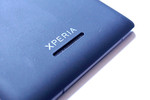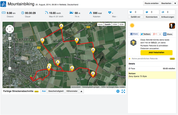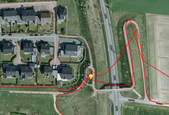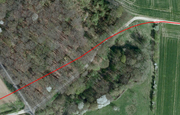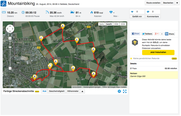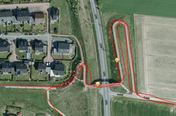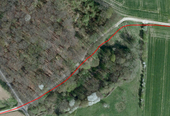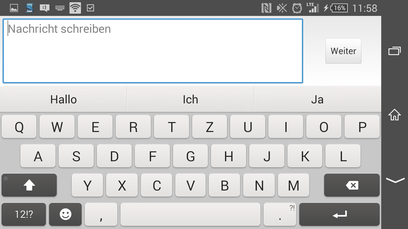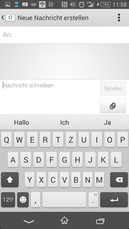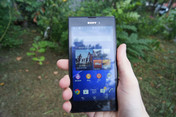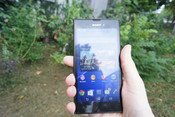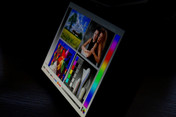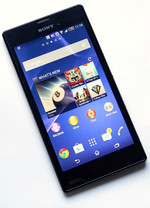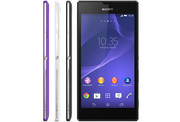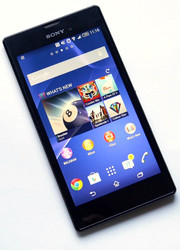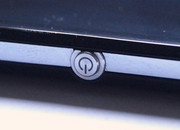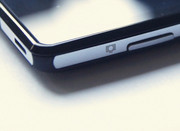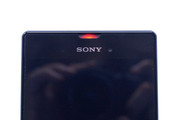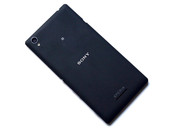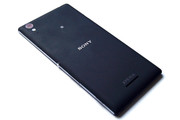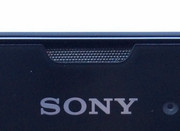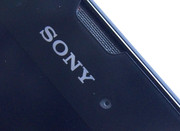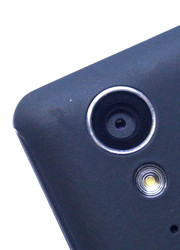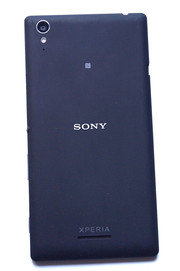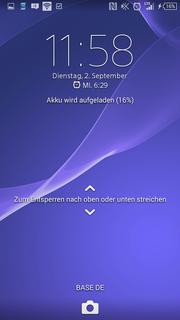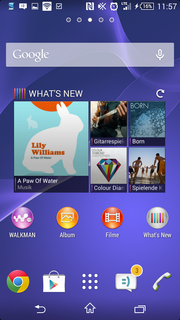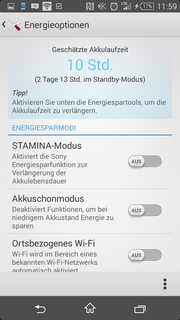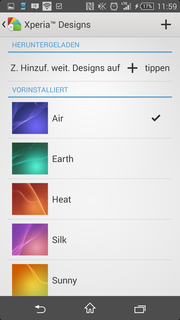Sony Xperia T3 Smartphone Review

For the original German review, see here.
Sony's Xperia T3 Style is currently available for below 300 Euros (~$385). In particular, the looks of this mid-range device already make the impression of a flagship. The following report will reveal whether the hardware underlines this impression.
Sony's phone has a solid base with both the 5.3-inch screen with a resolution of 1280x720 pixels and the CPU in the form of the tried Snapdragon 400 MSM8928-2 SoC. The rear-facing camera has a sufficient resolution of 8 megapixels unlike the front-facing unit that may disappoint selfie fans with 1.1 megapixels. The RAM has a capacity of 1 GB, and the graphics engine is the integrated Adreno 305 chipset. Sony's Xperia T3 Style even offers high-speed LTE. Sony is up-to-date in terms of operating system and installs the latest Android 4.4 KitKat version.
We opted for HTC's Desire 816 and the still very popular and affordable Motorola Moto G for comparison. HTC's Desire 816 is similar to Sony's Xperia T3 Style in height, screen size and SoC. Motorola's Moto G has a screen size of 4.5-inches, but it is in HD resolution and the device is also powered by a Snapdragon 400. Since a performance comparison with a different chipset is also interesting, we additionally compared Archos' 50c Oxygen with our review sample.
Case
Sony's Xperia T3 Style is comprised of metal and plastic. Plastic is clearly the prevailing material. The bezel with metal parts gives the smartphone a quality impression, and the plastic back looks rigid. The back has an almost velvety feel and provides a good grip. With a height of just 7.7 millimeters, the device is very slim. It is also relatively light with a weight of only 148 grams. The back, unfortunately, attracts fingerprints, and thus regular polishing will become routine for users who greatly value appearance.
The back cannot be removed either and thus prevents replacing the battery. We tested the black model, but the device is also available in white or purple for buyers who prefer these colors. The message LED that is integrated into the receiver is certainly a highlight. It lets the smartphone clearly stand out from its contenders. A feature which has proven itself in many of the manufacturer's devices is Sony's protruding power button.
Connectivity
In contrast to Sony's current Xperia Z2 flagship, the Xperia T3 does not have any protection against dust or water. However, the user will discover a dedicated camera button and a robust casing. The Snapdragon 400 chipset and the 5.3-inch screen with a resolution of 1280x720 pixels clearly show the mid-range orientation. The 1 GB of working memory and the 8 GB of internal storage fit to that. Only 4.9 GB is available for the user ex-factory. However, the storage capacity can be expanded via an SD card. It is also then possible to move apps to the memory card.
Sony integrates the most important radio standards in the forms of Wi-Fi 802.11 a/b/g/n, Bluetooth 4.0, NFC, GPS, and LTE CAT4. However, some users will miss HDMI or MHL as cabled connections. For a device of this price range, the Xperia T3 also has a generously sized 2500 mAh battery just from a nominal value point of view.
Software
Sony preloads Android 4.4.2 KitKat on its Xperia Style. Thus, the user will find a very up-to-date software platform from Google. The manufacturer also includes many proprietary apps, such as the applications "Walkman" for listening to music, "Album" for the user's picture gallery, and "Movies" for watching videos. A PlayStation app is not installed, but there is Smart Connect that allows mapping specific actions when the phone connects to another device or peripherals. Sony installs its own UI for the Android operating system interface.
Communication & GPS
Although the Xperia T3 Style cannot offer the fast Wi-Fi standard 802.11 ac, the speed is decent. Wi-Fi 802.11 a/b/g/n is available and should be enough for most tasks. The signal strength was always on a high level. Owing to high-speed LTE CAT4, the user can browse on mobile Internet with up to 150 Mbps. In fact, an LTE connection was almost always available in the E-Plus network in the city center.
The installed GPS module also supports the Russian GLONASS satellite navigation system. Like in other Android smartphones, it is possible to use Wi-Fi or mobile Internet for a faster and more efficient localization via A-GPS. Tracking functioned quite well on our bike tour using Sony's Xperia T3 Style and Garmin's Edge 500 navigation system. Both systems mostly coincided in distance and speed, but the smartphone was clearly inferior in altitude.
Furthermore, navigating in bad weather did not always function smoothly right away. The device was localized within a few seconds in better weather.
Telephony & Speech Quality
Sony's Xperia Style fared quite well in the main exercise for a cellphone. A micro-SIM card is needed, and it is inserted underneath a flap. Our contact was loud and clear, and there was no problem the other way around either. We did not experience any network interruptions or noise during the test. The reception was always on a high standard.
Cameras & Multimedia
Sony's Xperia T3 features an 8-megapixel camera with Sony's Exmor RS sensor. However, too much should not be expected from the lens. The review sample does not reach the quality of smartphone contenders like Nokia's Lumia 1020 or that of a real camera, such as the Alpha 57. The pictures tend to overexpose and lack sharpness. Fine structures quickly look faded and relatively few details can be recognized even in good light. However, the color accuracy is satisfactory. The auto-focus could be a bit faster though it is quite accurate.
An LED flash beside the camera illuminates the surroundings quite effectively, but it affects the focus. However, color noise is low. Videos can be recorded in Full HD quality and are still acceptable even in weaker light. The frame rate remains consistent. Sony also treats its Xperia T3 to a 1.1-megapixel front-facing camera. Although it does not have auto-focus, selfies are taken in a good quality and it is also suitable for video calls.
Accessories
An in-ear headset alongside a micro-USB cable and charger are found in the box. Sony covers the basics with these accessories. Optional accessories, such as the SmartBand SWR10 fitness wrist strap or Sony's SmartWatch 2, are also available. A vast selection of protection cases and covers for the Xperia T3 Style already exists.
Warranty
Sony includes a 24-month warranty period in some countries. Warranty upgrades are not offered.
Input Devices & Controls
Sony's Xperia T3 is exclusively used via its 5.3-inch touchscreen. It responds accurately and promptly without noticeable lags. The phone responds swiftly immediately after system start and loading the home screen elements, and it implements actions without delay. Sony does not install a physical menu button. Instead, it relies on the concept of virtual controls. Like the rest of the screen, they also respond quickly.
The volume rocker, power button and camera button are metal and feature good haptics. There were no problems in everyday use. The virtual keyboard can also be used with stroke gestures similar to swype, and it has a sufficient size. It is even more comfortable to use in landscape mode.
Display
The 5.3-inch screen has a resolution of 1280x720 pixels. The Full HD standard is common for this screen size, but it is not noticed adversely here. Unlike its competitors, Sony still does not use IPS or AMOLED. Instead, Sony installs its Triluminos LCD screen. The colors look very brilliant owing to the Mobile Bravia Engine 2. In particular, the screen brightness of Sony's phone is exciting. The maximum brightness in the screen's center is 521 cd/m². The Desire 816 can only oppose that with 431 cd/m², the Moto G with 441 cd/m², and the Archos 50c comes in last with 426 cd/m² in the screen's center.
| |||||||||||||||||||||||||
Brightness Distribution: 89 %
Center on Battery: 521 cd/m²
Contrast: 677:1 (Black: 0.77 cd/m²)
ΔE ColorChecker Calman: 5.73 | ∀{0.5-29.43 Ø4.82}
ΔE Greyscale Calman: 6.83 | ∀{0.09-98 Ø5.1}
Gamma: 3.46
CCT: 8370 K
The phone cannot offer a deep black for technical reasons. Nevertheless, the black level of 0.77 cd/m² is quite low. However, HTC's Desire 816 achieves a better black level of 0.55 cd/m². Motorola's Moto G even has an edge on that with a black level of 0.54 cd/m². The screen in Archos' 50c Oxygen proves that worse is possible - the manufacturer still has room for improvement with a rate of 1.02 cd/m².
Reflections are clearly visible in outdoor use. However, content remains easily readable when the smartphone is not tilted strongly toward direct sunlight, though problems could occur in very bright light. The screen in the Xperia T3 can be used even in acute angles without massive quality losses.
Performance
The quad-core Qualcomm Snapdragon 400 MSM8928-2 SoC clocks with 1.4 GHz and uses the integrated Adreno 305 as the graphics accelerator. The working memory has a capacity of 1 GB of RAM. This tried hardware basis was noticed favorably in the performance tests.
Sony's Xperia T3 Style looks impressive in the synthetic benchmarks compared with the HTC Desire 816 and Motorola Moto G rivals. The octa-core MT6592 from MediaTek in the Archos 50c Oxygen has an advantage owing to its eight cores in 3DMark despite its relatively old architecture. The Xperia Style is on par with its contenders in the GFX Bench 3.0.
| Geekbench 3 | |
| 32 Bit Single-Core Score (sort by value) | |
| Sony Xperia T3 | |
| Motorola Moto G 1. Gen XT1032 | |
| HTC Desire 816 | |
| 32 Bit Multi-Core Score (sort by value) | |
| Sony Xperia T3 | |
| Motorola Moto G 1. Gen XT1032 | |
| HTC Desire 816 | |
| Linpack Android / IOS | |
| Single Thread (sort by value) | |
| Sony Xperia T3 | |
| Motorola Moto G 1. Gen XT1032 | |
| Archos 50c Oxygen | |
| HTC Desire 816 | |
| Multi Thread (sort by value) | |
| Sony Xperia T3 | |
| Motorola Moto G 1. Gen XT1032 | |
| Archos 50c Oxygen | |
| HTC Desire 816 | |
| Epic Citadel - High Quality (sort by value) | |
| Sony Xperia T3 | |
| Motorola Moto G 1. Gen XT1032 | |
| Archos 50c Oxygen | |
| HTC Desire 816 | |
| 3DMark - 1920x1080 Ice Storm Extreme Score (sort by value) | |
| Sony Xperia T3 | |
| Motorola Moto G 1. Gen XT1032 | |
| Archos 50c Oxygen | |
| HTC Desire 816 | |
| AndEBench | |
| Java (sort by value) | |
| Sony Xperia T3 | |
| Motorola Moto G 1. Gen XT1032 | |
| HTC Desire 816 | |
| Native (sort by value) | |
| Sony Xperia T3 | |
| Motorola Moto G 1. Gen XT1032 | |
| HTC Desire 816 | |
Browsing on the Internet with Sony's Xperia T3 Style is quite swift even if the synthetic benchmarks do not really reflect that. However, Motorola's Moto G outpaces it though. No losses were noticed when browsing via Wi-Fi or via the mobile network in routine use.
| Octane V2 - Total Score (sort by value) | |
| Sony Xperia T3 | |
| Archos 50c Oxygen | |
| HTC Desire 816 | |
| Sunspider - 1.0 Total Score (sort by value) | |
| Sony Xperia T3 | |
| Motorola Moto G 1. Gen XT1032 | |
| Archos 50c Oxygen | |
| HTC Desire 816 | |
| Peacekeeper - --- (sort by value) | |
| Sony Xperia T3 | |
| Motorola Moto G 1. Gen XT1032 | |
| Archos 50c Oxygen | |
| HTC Desire 816 | |
| Mozilla Kraken 1.1 - Total (sort by value) | |
| Sony Xperia T3 | |
| Archos 50c Oxygen | |
| HTC Desire 816 | |
* ... smaller is better
The relatively slow storage of HTC's Desire 816 is noticed in AndroBench 3. Archos' 50c Oxygen is markedly faster, and Motorola's Moto G has the lead on the Xperia T3 Style's contenders. The swift read access of Sony's phone is particularly impressive.
| AndroBench 3-5 | |
| Random Write 4KB (sort by value) | |
| Sony Xperia T3 | |
| HTC Desire 816 | |
| Motorola Moto G 1. Gen XT1032 | |
| Archos 50c Oxygen | |
| Random Read 4KB (sort by value) | |
| Sony Xperia T3 | |
| HTC Desire 816 | |
| Motorola Moto G 1. Gen XT1032 | |
| Archos 50c Oxygen | |
| Sequential Write 256KB (sort by value) | |
| Sony Xperia T3 | |
| HTC Desire 816 | |
| Motorola Moto G 1. Gen XT1032 | |
| Archos 50c Oxygen | |
| Sequential Read 256KB (sort by value) | |
| Sony Xperia T3 | |
| HTC Desire 816 | |
| Motorola Moto G 1. Gen XT1032 | |
| Archos 50c Oxygen | |
Games
The Qualcomm Snapdragon 400 MSM8928 SoC in conjunction with a 1 GB working memory provided a good gaming performance. We used the games Dead Trigger 2 and Ridge Racer Slipstream to test the 3D performance. The games always ran smoothly and in a good visual quality. Even 2D games like Angry Birds Star Wars II were no problem for the smartphone.
Emissions
Temperature
We recorded a maximum of 46 °C with our infrared thermometer on the back of Sony's Xperia T3 Style. That already feels warm, but this temperature is only reached under permanent full load. The power supply exhibited a similar temperature, but it is not yet critical. The temperatures were always within a very moderate range during normal use. Sony's smartphone never went beyond lukewarm.
(±) The maximum temperature on the upper side is 43.7 °C / 111 F, compared to the average of 35.2 °C / 95 F, ranging from 21.9 to 247 °C for the class Smartphone.
(-) The bottom heats up to a maximum of 46 °C / 115 F, compared to the average of 33.9 °C / 93 F
(+) In idle usage, the average temperature for the upper side is 28.6 °C / 83 F, compared to the device average of 32.9 °C / 91 F.
Speakers
Sony only installs a mono speaker in its Xperia T3 Style. The sound quality is nevertheless satisfactory. Although the trebles are not outstanding and there is no bass, the smartphone does not exhibit any major flaws. Only the switch from the second last to the last volume level was a bit too brutal. The phone should be put on its screen when listening to music because the speaker is in the lower back.
Energy Management
Power Consumption
Sony integrates a 2500 mAh battery that cannot be removed. The Xperia T3 is fairly modest when idling and consumes a maximum of only 1.8 watts. However, the smartphone's power consumption, unfortunately, increases to quite an extent in load with up to 4.9 watts. HTC's Desire 816 has a slightly larger, 5.5-inch screen but is considerably more frugal with a maximum of 3.5 watts during load. This is also noticed in the battery runtime of Sony's device.
| Off / Standby | |
| Idle | |
| Load |
|
Key:
min: | |
Battery Runtime
We recorded an idle runtime of 19 hours and 29 minutes using minimum brightness. The energy-saving mode was enabled, and all radio modules except for Wi-Fi were disabled. That is almost 6 hours less than the runtime of Motorola's Moto G and HTC's Desire 816. The Xperia T3 Style, unfortunately, did not last longer than 1 hour 58 minutes during load (maximum brightness, all radio modules on). The described power consumption takes its toll here. Motorola's Moto G lasts twice as long here, and HTC's Desire 816 even longer. The battery of the Xperia T3 Style was drained after 10 hours and 34 minutes in the browsing test. That is just below the runtime of HTC's Desire 816, but considerably shorter than that of Motorola's Moto G.
Verdict
There are several points that make Sony's Xperia T3 Style appealing. Firstly, we very much liked the screen with its exemplary brightness. Then, the smartphone scored with its build, including the metal bezel. The operating speed and gaming performance also proved good, and the message LED in the receiver is a stylish design feature. The swift Internet speed also has to be highlighted, and the speed of the internal storage is fast.
However, the Xperia T3 Style also has its shortcomings. The biggest one is found in battery runtime. The relatively high power consumption during high load drains the smartphone faster than contenders based on the same chipset. Furthermore, Sony's 8-megapixel camera was not completely convincing. The pictures were sometimes too blurry, and the auto-focus needed quite some time. Lastly, we have to reproach the installed speaker a bit. A better speaker would have added value to the smartphone.
Despite that, it can be said that Sony's Xperia T3 Style is a well-conceived smartphone. Perhaps Sony will be able to increase the battery runtime with a software update. However, buyers who are not deterred by this or the middling camera will get a well-built smartphone with a stylish design and good operating speed.




